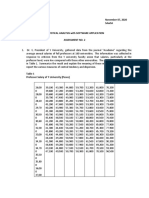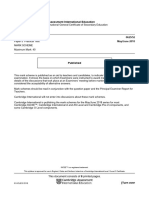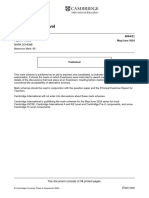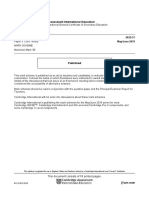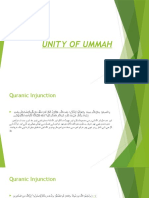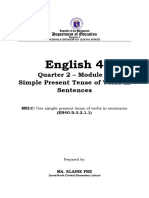Cambridge Assessment International Education: Physics 9702/43 October/November 2018
Cambridge Assessment International Education: Physics 9702/43 October/November 2018
Uploaded by
Muhammad AhmedCopyright:
Available Formats
Cambridge Assessment International Education: Physics 9702/43 October/November 2018
Cambridge Assessment International Education: Physics 9702/43 October/November 2018
Uploaded by
Muhammad AhmedOriginal Title
Copyright
Available Formats
Share this document
Did you find this document useful?
Is this content inappropriate?
Copyright:
Available Formats
Cambridge Assessment International Education: Physics 9702/43 October/November 2018
Cambridge Assessment International Education: Physics 9702/43 October/November 2018
Uploaded by
Muhammad AhmedCopyright:
Available Formats
Cambridge Assessment International Education
Cambridge International Advanced Subsidiary and Advanced Level
PHYSICS 9702/43
Paper 4 A Level Structured Questions October/November 2018
MARK SCHEME
Maximum Mark: 100
Published
This mark scheme is published as an aid to teachers and candidates, to indicate the requirements of the
examination. It shows the basis on which Examiners were instructed to award marks. It does not indicate the
details of the discussions that took place at an Examiners’ meeting before marking began, which would have
considered the acceptability of alternative answers.
Mark schemes should be read in conjunction with the question paper and the Principal Examiner Report for
Teachers.
Cambridge International will not enter into discussions about these mark schemes.
Cambridge International is publishing the mark schemes for the October/November 2018 series for most
Cambridge IGCSE™, Cambridge International A and AS Level components and some Cambridge O Level
components.
This document consists of 12 printed pages.
© UCLES 2018 [Turn over
9702/43 Cambridge International AS/A Level – Mark Scheme October/November 2018
PUBLISHED
Generic Marking Principles
These general marking principles must be applied by all examiners when marking candidate answers. They should be applied alongside the
specific content of the mark scheme or generic level descriptors for a question. Each question paper and mark scheme will also comply with these
marking principles.
GENERIC MARKING PRINCIPLE 1:
Marks must be awarded in line with:
• the specific content of the mark scheme or the generic level descriptors for the question
• the specific skills defined in the mark scheme or in the generic level descriptors for the question
• the standard of response required by a candidate as exemplified by the standardisation scripts.
GENERIC MARKING PRINCIPLE 2:
Marks awarded are always whole marks (not half marks, or other fractions).
GENERIC MARKING PRINCIPLE 3:
Marks must be awarded positively:
• marks are awarded for correct/valid answers, as defined in the mark scheme. However, credit is given for valid answers which go beyond the
scope of the syllabus and mark scheme, referring to your Team Leader as appropriate
• marks are awarded when candidates clearly demonstrate what they know and can do
• marks are not deducted for errors
• marks are not deducted for omissions
• answers should only be judged on the quality of spelling, punctuation and grammar when these features are specifically assessed by the
question as indicated by the mark scheme. The meaning, however, should be unambiguous.
GENERIC MARKING PRINCIPLE 4:
Rules must be applied consistently e.g. in situations where candidates have not followed instructions or in the application of generic level
descriptors.
© UCLES 2018 Page 2 of 12
9702/43 Cambridge International AS/A Level – Mark Scheme October/November 2018
PUBLISHED
GENERIC MARKING PRINCIPLE 5:
Marks should be awarded using the full range of marks defined in the mark scheme for the question (however; the use of the full mark range may
be limited according to the quality of the candidate responses seen).
GENERIC MARKING PRINCIPLE 6:
Marks awarded are based solely on the requirements as defined in the mark scheme. Marks should not be awarded with grade thresholds or
grade descriptors in mind.
© UCLES 2018 Page 3 of 12
9702/43 Cambridge International AS/A Level – Mark Scheme October/November 2018
PUBLISHED
Question Answer Marks
1(a)(i) work done per unit mass B1
work done moving mass from infinity (to the point) B1
1(a)(ii) (near Earth’s surface change in) height ≪ radius or height much less than radius B1
potential inversely proportional to radius and radius approximately constant (so potential approximately constant) B1
1(b) initial kinetic energy = (–) potential energy (at surface) B1
or
½mv2 = GMm / r
v2 = (2 × 6.67 × 10–11 × 7.4 × 1022) / (0.5 × 3.5 × 106) C1
v = 2.4 × 103 m s–1 A1
Question Answer Marks
2(a) sum of potential and kinetic energies (of molecules/atoms/particles) B1
(energy of) molecules/atoms/particles in random motion B1
2(b)(i) final temperature = initial temperature B1
no change in internal energy B1
2(b)(ii) 1. work done on gas (P→Q): 0 A1
increase in internal energy (P→Q): (+)97.0 J A1
2. increase in internal energy (Q→R): –42.5 J A1
3. increase in internal energy (R→P): –54.5 J A1
thermal energy supplied (R→P): –91.5 J A1
© UCLES 2018 Page 4 of 12
9702/43 Cambridge International AS/A Level – Mark Scheme October/November 2018
PUBLISHED
Question Answer Marks
3(a) ω2 = 2g / L C1
T = 2π / ω C1
ω2 = (2 × 9.81) / 0.19 A1
ω = 10.2 (rad s–1)
T = 2π / 10.2
= 0.62 s
3(b)(i) e.g. viscosity of liquid/friction within the liquid/viscous drag/friction between walls of tube and liquid B1
3(b)(ii) (maximum) KE = ½mv02 and v0 = ωx0 C1
or
energy = ½mω2x02
change = ½ × 18 × 10–3 × 103 × [(2.0 × 10–2)2 – (0.95 ×10–2)2] C1
= 2.9 × 10–4 J A1
© UCLES 2018 Page 5 of 12
9702/43 Cambridge International AS/A Level – Mark Scheme October/November 2018
PUBLISHED
Question Answer Marks
4(a) pulses (of ultrasound from generator) B1
reflected at boundaries (between media) B1
time delay (between transmission and receipt) gives information about depth B1
intensity of reflected pulse gives information about nature (of tissues)/type (of tissues)/boundary B1
Any two from: B2
• (reflected pulses) detected by the (ultrasound) generator
• gel used to minimise reflection at skin/maximise transmission into skin
• degree of reflection depends upon impedances of two media (at boundary)
4(b)(i) product of density and speed M1
speed of ultrasound in medium A1
4(b)(ii) Z1 about equal to Z2 results in negligible/no reflection B1
Z1 ≫ Z2 (or Z1 ≪ Z2) results in mostly reflection B1
© UCLES 2018 Page 6 of 12
9702/43 Cambridge International AS/A Level – Mark Scheme October/November 2018
PUBLISHED
Question Answer Marks
5(a) Any two reasonable suggestions e.g.: B2
• noise can be eliminated/(signal/data) can be regenerated
• bits can be added to correct for errors
• data compression/multiplexing (is possible)
• signal can be encrypted/better security
5(b) sketch: series of seven steps B1
each step width 2 ms B1
correct levels in correct order (2, 5, 14, 4, 9, 11, 7) A2
(1 mark for 6 levels correct, 2 marks for 7 levels correct)
5(c)(i) step width reduced B1
or
higher frequencies can be reproduced
5(c)(ii) step height reduced B1
or
smaller changes in signal (intensity) can be reproduced
Question Answer Marks
6(a)(i) work done per unit charge B1
work done moving positive charge from infinity (to the point) B1
6(a)(ii) field strength = potential gradient M1
‘–’ sign included or directions discussed A1
6(b)(i) gain in kinetic energy (= loss in potential energy) = charge × p.d. or qV = ½mv2 M1
so v is independent of separation (because separation not in expressions) A1
© UCLES 2018 Page 7 of 12
9702/43 Cambridge International AS/A Level – Mark Scheme October/November 2018
PUBLISHED
Question Answer Marks
6(b)(ii) (at x = 0.40 cm), potential = (–) 75 × 0.40 / 1.2 C1
(= (–) 25 V)
½mv2 = qV C1
½ × 4 × 1.66 × 10–27 × v2 = 2 × 1.60 × 10–19 × 25
or
a = Vq / dm and v2 = 2as (C1)
v2 = (2 × 75 × 2 × 1.60 × 10–19 × 0.40 × 10–2) / (1.2 × 10–2 × 4 × 1.66 × 10–27) (C1)
v = 4.9 × 104 m s–1 A1
Question Answer Marks
7(a)(i) gain is constant M1
for all frequencies A1
7(a)(ii) no time delay between input (voltage) and output (voltage) B1
clear reference to change(s) in input and/or output (voltages) B1
7(b) diagram: VIN connected to V+ only B1
midpoint between resistors R1 and R2 connected to V– only B1
7(c)(i) –3.6 V A1
7(c)(ii) (+)5.0 V A1
© UCLES 2018 Page 8 of 12
9702/43 Cambridge International AS/A Level – Mark Scheme October/November 2018
PUBLISHED
Question Answer Marks
8(a) region where there is a force M1
experienced by a current-carrying conductor/moving charge/(permanent) magnet A1
8(b)(i) single path, deflection in ‘upward’ direction B1
acceptable circular arc in whole field B1
no ‘kinks’ at start or end of curvature, and straight outside region of field B1
8(b)(ii) force (on particle) is normal to velocity/direction of motion/direction of speed B1
8(c) magnetic force provides/is the centripetal force B1
Bqv = mv2 / r or r = mv / Bq C1
(if q is doubled), new speed = 2v A1
© UCLES 2018 Page 9 of 12
9702/43 Cambridge International AS/A Level – Mark Scheme October/November 2018
PUBLISHED
Question Answer Marks
9(a) (induced) e.m.f. proportional/equal to rate M1
of change of (magnetic) flux (linkage) A1
9(b)(i) induced e.m.f. = (∆B)AN / ∆t C1
= (2 × 0.19 × 1.5 × 10–4 × 120) / 0.13
= 0.053 V A1
9(b)(ii) reading on voltmeter connected to coil C / V: 0 0.053 0 A1
(all three values required)
reading on voltmeter connected to Hall probe / V: zero in middle column B1
final column correct sign (negative) B1
final column correct magnitude (0.20) B1
Question Answer Marks
10 Any five points from: B5
• as temperature rises electrons gain energy
• electrons enter conduction band
• (positively charged) holes left in valence band
• more charge carriers (so resistance decreases)
• (as temperature rises,) lattice vibrations increase
• effect of increase in number of electrons or holes or charge carriers outweighs effect of increased lattice vibrations (so
resistance decreases)
© UCLES 2018 Page 10 of 12
9702/43 Cambridge International AS/A Level – Mark Scheme October/November 2018
PUBLISHED
Question Answer Marks
11(a) discrete amount/quantum/packet of energy M1
of electromagnetic radiation A1
11(b)(i) energy = hc / λ C1
λ = (6.63 × 10–34 × 3.00 × 108) / (0.51 × 106 × 1.60 × 10–19) A1
= 2.4 × 10–12 m
11(b)(ii) p = h / λ C1
= (6.63 × 10–34) / (2.44 × 10–12)
or
p = E / c
= (0.51 × 1.60 × 10–13) / (3.00 × 108)
p = 2.7 × 10–22 N s A1
11(c)(i) E = c2∆m C1
∆m = (0.51 × 1.60 × 10–13) / (3.00 × 108)2 A1
= 9.1 × 10–31 kg
11(c)(ii) (momentum is conserved so) nucleus must have momentum in opposite direction to photon B1
© UCLES 2018 Page 11 of 12
9702/43 Cambridge International AS/A Level – Mark Scheme October/November 2018
PUBLISHED
Question Answer Marks
12(a) unstable nucleus B1
emission of particles/photons B1
emission is spontaneous B1
or
(particles/radiation) are ionising
12(b)(i) tangent drawn and gradient calculation attempted B1
activity = 1.3 × 106 Bq A2
(1 mark for answer within ±0.2 × 106 Bq, 2 marks for answer within ±0.1 × 106 Bq)
12(b)(ii) A = λN C1
λ = (1.3 × 106) / (3.05 × 1010) = 4.3 × 10–5 s–1 (≈ 4 × 10–5 s–1) A1
12(c) A = A0e–λt C1
1.0 × 103 = 4.6 × 103 exp(–5.5 × 10–7 × t)
ln (4.6) = 5.5 × 10–7 × t C1
t = 2.78 × 106 s A1
= 32 days
© UCLES 2018 Page 12 of 12
You might also like
- Regents Exams and Answers Geometry Revised EditionFrom EverandRegents Exams and Answers Geometry Revised EditionNo ratings yet
- We Are Nothing and So Can YouDocument35 pagesWe Are Nothing and So Can YouJasper BernesNo ratings yet
- Role-Play in Building Self-AwarenessDocument22 pagesRole-Play in Building Self-Awarenessapi-280504764100% (2)
- Manalo, Cristian James P. November 07, 2020 BSA 2-11 SawsaDocument5 pagesManalo, Cristian James P. November 07, 2020 BSA 2-11 SawsaCristian James ManaloNo ratings yet
- Baja California Government Documents Collection UCSD La JollaDocument24 pagesBaja California Government Documents Collection UCSD La JollaAbraham UribeNo ratings yet
- Cambridge Assessment International Education: Physics 9702/22 March 2019Document9 pagesCambridge Assessment International Education: Physics 9702/22 March 2019Janice YohanaNo ratings yet
- Cambridge Assessment International Education: Physics 9702/42 March 2019Document12 pagesCambridge Assessment International Education: Physics 9702/42 March 2019Salaar AhmedNo ratings yet
- 0625 - s18 - Ms - 43 PaperDocument9 pages0625 - s18 - Ms - 43 Papersinghnidhi.dNo ratings yet
- Cambridge Assessment International Education: Physics 9702/42 October/November 2019Document14 pagesCambridge Assessment International Education: Physics 9702/42 October/November 2019pvaidehi9826No ratings yet
- Chemistry Igcse 0620 October 2023 Paper 6 Variant 3Document7 pagesChemistry Igcse 0620 October 2023 Paper 6 Variant 3sally.mansterlyNo ratings yet
- Cambridge Assessment International Education: Physics 0625/41 May/June 2018Document9 pagesCambridge Assessment International Education: Physics 0625/41 May/June 2018NyarlathotepNo ratings yet
- Cambridge Assessment International Education: Physics 0625/51 May/June 2018Document8 pagesCambridge Assessment International Education: Physics 0625/51 May/June 2018Tao FanNo ratings yet
- Cambridge Assessment International Education: Chemistry 9701/41 October/November 2019Document14 pagesCambridge Assessment International Education: Chemistry 9701/41 October/November 2019ffgfgfgffgNo ratings yet
- 9701 w18 Ms 41 PDFDocument14 pages9701 w18 Ms 41 PDFSuhail Alam KhanNo ratings yet
- June 2018 (v2) MSDocument16 pagesJune 2018 (v2) MShillarykeiratan18No ratings yet
- Cambridge Assessment International Education: Physics 0972/61 October/November 2018Document7 pagesCambridge Assessment International Education: Physics 0972/61 October/November 2018ggoated71No ratings yet
- Extended Theory: Cambridge Assessment International EducationDocument11 pagesExtended Theory: Cambridge Assessment International EducationRita SmairatNo ratings yet
- Cambridge Assessment International Education: Physics 0625/52 May/June 2018Document8 pagesCambridge Assessment International Education: Physics 0625/52 May/June 2018Tao FanNo ratings yet
- 9702 s19 Ms 23Document10 pages9702 s19 Ms 23Keya NandiNo ratings yet
- 5054 w18 Ms 21 PDFDocument10 pages5054 w18 Ms 21 PDFWorld Cricket HighlightsNo ratings yet
- Cambridge Assessment International Education: Physics 0625/42 March 2018Document11 pagesCambridge Assessment International Education: Physics 0625/42 March 2018Malek ElsawyNo ratings yet
- Cambridge IGCSE™: Physics 0625/42 March 2021Document10 pagesCambridge IGCSE™: Physics 0625/42 March 2021BertoNo ratings yet
- MS Cambridge O Accounting-11 112018Document20 pagesMS Cambridge O Accounting-11 112018ngwenyapetro164No ratings yet
- Cambridge Assessment International Education: Chemistry 0620/52 October/November 2018Document6 pagesCambridge Assessment International Education: Chemistry 0620/52 October/November 2018jonalsmithzNo ratings yet
- 0625 m18 Ms 62Document7 pages0625 m18 Ms 62Syed AshabNo ratings yet
- Cambridge Assessment International Education: Physics 0625/32 May/June 2018Document10 pagesCambridge Assessment International Education: Physics 0625/32 May/June 2018Tao FanNo ratings yet
- Cambridge Assessment International Education: Chemistry 9701/33 March 2019Document7 pagesCambridge Assessment International Education: Chemistry 9701/33 March 2019Trang NguyenNo ratings yet
- Cambridge Assessment International Education: Chemistry 9701/42 March 2018Document10 pagesCambridge Assessment International Education: Chemistry 9701/42 March 2018pratikNo ratings yet
- Cambridge Assessment International Education: Chemistry 9701/22 May/June 2018Document10 pagesCambridge Assessment International Education: Chemistry 9701/22 May/June 2018Cody MYNo ratings yet
- Cambridge Assessment International Education: Physics 9702/22 March 2019Document9 pagesCambridge Assessment International Education: Physics 9702/22 March 2019l.dhesiganNo ratings yet
- June 2022 Mark Scheme Paper 21Document11 pagesJune 2022 Mark Scheme Paper 21charitynalwimba9No ratings yet
- Cambridge Assessment International Education: Chemistry 5070/32 October/November 2019Document6 pagesCambridge Assessment International Education: Chemistry 5070/32 October/November 2019Prince YugNo ratings yet
- Cambridge Assessment International Education: Chemistry 9701/34 May/June 2018Document10 pagesCambridge Assessment International Education: Chemistry 9701/34 May/June 2018azadaland40No ratings yet
- Cambridge O Level: Physics 5054/21Document10 pagesCambridge O Level: Physics 5054/21rovesor307No ratings yet
- Cambridge Assessment International Education: Chemistry 9701/31 May/June 2019Document8 pagesCambridge Assessment International Education: Chemistry 9701/31 May/June 2019junjia.fang666No ratings yet
- 0625 s19 Ms 42 PDFDocument10 pages0625 s19 Ms 42 PDFhamnaNo ratings yet
- Cambridge Assessment International Education: Physics 0625/43 May/June 2018Document9 pagesCambridge Assessment International Education: Physics 0625/43 May/June 2018lolololi3030.gmNo ratings yet
- Cambridge Assessment International Education: Computer Science 9608/23 October/November 2019Document13 pagesCambridge Assessment International Education: Computer Science 9608/23 October/November 2019IGCSENo ratings yet
- 9701 s18 Ms 42 PDFDocument14 pages9701 s18 Ms 42 PDFSuhail Alam KhanNo ratings yet
- Cambridge Assessment International Education: Economics 2281/22 May/June 2018Document18 pagesCambridge Assessment International Education: Economics 2281/22 May/June 2018AdeenaNo ratings yet
- 0625 s18 Ms 42Document10 pages0625 s18 Ms 42nicky1213aNo ratings yet
- Cambridge Assessment International Education: Chemistry 0971/42 October/November 2018Document9 pagesCambridge Assessment International Education: Chemistry 0971/42 October/November 2018Khairun nissaNo ratings yet
- 0654 w18 Ms 41Document13 pages0654 w18 Ms 41Seve ReyesNo ratings yet
- Cambridge Assessment International Education: Physics 5054/21 May/June 2018Document11 pagesCambridge Assessment International Education: Physics 5054/21 May/June 2018Ayra MujibNo ratings yet
- Cambridge Assessment International Education: Combined Science 0653/42 October/November 2018Document8 pagesCambridge Assessment International Education: Combined Science 0653/42 October/November 2018gf.tandionoNo ratings yet
- Cambridge Assessment International Education: Physics 0625/31 May/June 2019Document12 pagesCambridge Assessment International Education: Physics 0625/31 May/June 2019Frank Ernesto Tarrau PrendesNo ratings yet
- 5054 w19 Ms 21 PDFDocument10 pages5054 w19 Ms 21 PDFLucasNo ratings yet
- Cambridge Assessment International Education: Chemistry 9701/22 March 2019Document9 pagesCambridge Assessment International Education: Chemistry 9701/22 March 2019SadiaShoaibNo ratings yet
- Cambridge IGCSE™: Physics 0625/42 May/June 2021Document11 pagesCambridge IGCSE™: Physics 0625/42 May/June 2021Noranita Mohd RashidiNo ratings yet
- O Level Physics 2018 MarkschemeDocument10 pagesO Level Physics 2018 MarkschemefordalNo ratings yet
- Cambridge Assessment International Education: Chemistry 0620/62 May/June 2018Document6 pagesCambridge Assessment International Education: Chemistry 0620/62 May/June 2018ahpungNo ratings yet
- Cambridge Assessment International Education: Chemistry 9701/42 May/June 2019Document13 pagesCambridge Assessment International Education: Chemistry 9701/42 May/June 2019Ali110No ratings yet
- Cambridge Assessment International Education: Chemistry 9701/31 October/November 2019Document8 pagesCambridge Assessment International Education: Chemistry 9701/31 October/November 2019princessdinah7No ratings yet
- Cambridge Assessment International Education: Chemistry 0620/53 May/June 2018Document6 pagesCambridge Assessment International Education: Chemistry 0620/53 May/June 2018Aaa IiiNo ratings yet
- Cambridge Assessment International Education: Physics 9702/32 May/June 2018Document7 pagesCambridge Assessment International Education: Physics 9702/32 May/June 2018xhtxsteveNo ratings yet
- Cambridge Assessment International Education: Business 9609/31 October/November 2019Document19 pagesCambridge Assessment International Education: Business 9609/31 October/November 2019Danny DrinkwaterNo ratings yet
- Cambridge IGCSE™: Physics 0625/32 March 2021Document10 pagesCambridge IGCSE™: Physics 0625/32 March 2021saidomarahNo ratings yet
- PP Chem MsDocument10 pagesPP Chem MsSabeeha MansoorNo ratings yet
- November 2020 (v1) MSDocument12 pagesNovember 2020 (v1) MSgeraldinemambwere08No ratings yet
- Cambridge Assessment International Education: Physics 9702/23 October/November 2017Document7 pagesCambridge Assessment International Education: Physics 9702/23 October/November 2017Abdullah RazzaqNo ratings yet
- November 2018 (v2) MSDocument10 pagesNovember 2018 (v2) MSkashviNo ratings yet
- Introduction-MaterialscienceDocument45 pagesIntroduction-MaterialscienceMuhammad AhmedNo ratings yet
- Composite MaterialsDocument40 pagesComposite MaterialsMuhammad AhmedNo ratings yet
- Heat Treatment of MetalsDocument20 pagesHeat Treatment of MetalsMuhammad AhmedNo ratings yet
- Unity of Ummah New SlidesDocument17 pagesUnity of Ummah New SlidesMuhammad AhmedNo ratings yet
- Cambridge International Advanced Subsidiary and Advanced LevelDocument12 pagesCambridge International Advanced Subsidiary and Advanced LevelMuhammad AhmedNo ratings yet
- Cambridge International Examinations: Physics 9702/43 May/June 2017Document12 pagesCambridge International Examinations: Physics 9702/43 May/June 2017Muhammad AhmedNo ratings yet
- 9702 w10 QP 41 PDFDocument24 pages9702 w10 QP 41 PDFMuhammad AhmedNo ratings yet
- Evaluation of The Role of Encryption Techniques in E CommerceDocument10 pagesEvaluation of The Role of Encryption Techniques in E CommerceLame Segokgo100% (2)
- E-Appointment Service - Development Report - Ver 1.0Document116 pagesE-Appointment Service - Development Report - Ver 1.0Jaswinder Singh NarulaNo ratings yet
- The Hyborian Age BRPDocument9 pagesThe Hyborian Age BRPWes100% (1)
- Exercises 12Document12 pagesExercises 12ReithabetseNo ratings yet
- Instant Access to Employment Law for Business Students UK edition Janice Nairns ebook Full ChaptersDocument71 pagesInstant Access to Employment Law for Business Students UK edition Janice Nairns ebook Full Chaptersstosscorangb100% (1)
- The One Per CentDocument4 pagesThe One Per CentEliot FintushelNo ratings yet
- Impact PlayerDocument8 pagesImpact PlayerAumi NadimNo ratings yet
- Prevalence of Alcohol Impaired Long Distance Commercial Drivers in Aba and UmuahiaDocument11 pagesPrevalence of Alcohol Impaired Long Distance Commercial Drivers in Aba and UmuahiaInternational Journal of Innovative Science and Research Technology100% (1)
- Ucsp Hand-Outs Module 1Document3 pagesUcsp Hand-Outs Module 1Joa PingalNo ratings yet
- The Clockmaker's DaughterDocument2 pagesThe Clockmaker's DaughternicksmcdonaldNo ratings yet
- Acg Module 9 Thc5-LathDocument10 pagesAcg Module 9 Thc5-LathMeishein FanerNo ratings yet
- Press Release: Lexington Police DepartmentDocument1 pagePress Release: Lexington Police Departmentapi-239704480No ratings yet
- India - Political Divisions and Physical FeaturesDocument61 pagesIndia - Political Divisions and Physical FeaturesemlynjiteshtNo ratings yet
- Jupiter Z PartDocument68 pagesJupiter Z PartAnonymous uz5Vo78No ratings yet
- VME Precast Profile PDFDocument187 pagesVME Precast Profile PDFShabbir LokhandwalaNo ratings yet
- Kitajska PodjetjaDocument12 pagesKitajska PodjetjaTroubleshootingNo ratings yet
- Bo de Thi Hoc Sinh Gioi Cap Tinh Mon Tieng Anh Lop 12 Co Dap AnDocument66 pagesBo de Thi Hoc Sinh Gioi Cap Tinh Mon Tieng Anh Lop 12 Co Dap AnThao VuNo ratings yet
- English 4 Q2 M5 Week5 MELC05 Simple Present Tense of Verbs - MaElainePre - FINALDocument11 pagesEnglish 4 Q2 M5 Week5 MELC05 Simple Present Tense of Verbs - MaElainePre - FINALLaine RepNo ratings yet
- Case 10-1 - Group 3 - ZDocument19 pagesCase 10-1 - Group 3 - Zvonny corneliaNo ratings yet
- 11le 01 Pa Constitution ST 019Document4 pages11le 01 Pa Constitution ST 019Delecia ConnleyNo ratings yet
- Ebook PDF CB New Engaging Titles From 4ltr Press 8th Edition PDFDocument41 pagesEbook PDF CB New Engaging Titles From 4ltr Press 8th Edition PDFjohn.vail635100% (48)
- PATRI Framework For Scaling Social ImpactDocument26 pagesPATRI Framework For Scaling Social ImpactRizwan Tayabali50% (2)
- Die_with_Zero_31052024_052149_PMDocument3 pagesDie_with_Zero_31052024_052149_PMyayicat943No ratings yet
- DLL - Mapeh 6 - Q2 - W5-JLMTDocument6 pagesDLL - Mapeh 6 - Q2 - W5-JLMTnekorish 2No ratings yet
- TXN Date Value Date Description Ref No./Cheque No. Branch Code Debit Credit BalanceDocument7 pagesTXN Date Value Date Description Ref No./Cheque No. Branch Code Debit Credit Balancecrmfinance.tnNo ratings yet
- Summary and Analysis EliminatingDocument2 pagesSummary and Analysis EliminatingKrishnanunni Karayil UllasNo ratings yet



